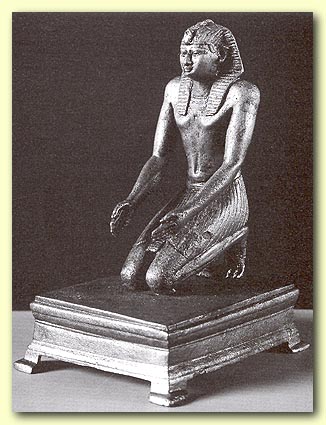NARMER (GREEK: MENES)
Before Narmer, the villages of Egypt were not together as one nation, but separate worlds. Narmer brought a common culture and religion to the land on the Nile, that would last 3,000 years. Succeeding all local rulers, he built an elaborate capital at Memphis and an earthen tomb for himself. From Narmer sprang the 1st Dynasty, and the Old Kingdom of Egypt was born. Right: Narmer smacks a defiant peasant on the head, showing off his power as king.
3130-3080
Founding Pharaoh of Egypt
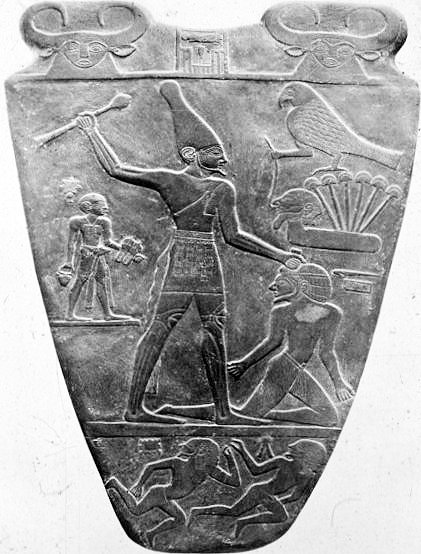
DJOSER (GREEK: ZOSER)
Old Kingdom Pharaoh of the 3rd Dynasty who expanded pharaonic power, he began the custom of building pyramidal shaped tombs of great size. The Step Pyramid of Saqqara was the result of this labor, the first large stone structure ever built by human hands (200 ft. high), which makes it also therefore the oldest large structure on Earth. Right: Djoser Statue.
2685-2640
Pharaoh of Egypt
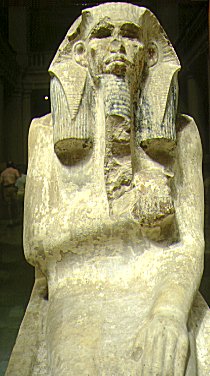
IMHOTEP
Pioneering ancient architect to Pharaoh Djoser, who drew up the plans and executed the design for the Step Pyramid. The pharaoh being well pleased with his work, Imhotep was honored in statuary.
2680-2630
Egyptian Architect
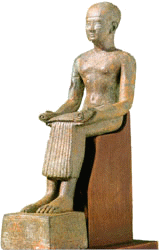
SNEFERU
Egypt under the 4th Dynasty reached a peak of ancient glory and stability. Sneferu, just and fair, ushered this era in and was put to rest in the Bent Pyramid of Dashur, which is the first true pyramid, smooth, not stepped. Cedar was imported for this from the Levant, and other products from Nubia, indicating a widening trade area.
2640-2580
Pharaoh of Egypt
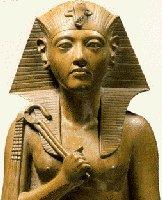
KHUFU (GREEK: CHEOPS)
Under Khufu's golden and divine command, Egypt had a population of 2 million. He built the 481 ft. high Great Pyramid of Giza, the first wonder of the world. The Nile was busy with merchant trade under him, with quarried material, food, people and goods brought from villages to the capital and back. The Great Pyramid is the only one of the 7 Wonders still standing.
2610-2560
Pharaoh of Egypt
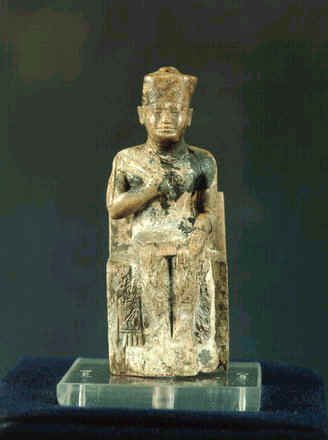
KHAFRA (GREEK: CEPHEREN)
Continued the successful rule of the 4th Dynasty over the land, as Egyptians believed in a balance of life called ma'at, which the pharaoh helped maintain. His name means 'appearing like Ra (the sun god)', and it is his face is found on the Great Sphinx, which he built along with the other large pyramid of Giza, next to that of his father.
2580-2520
Pharaoh of Egypt
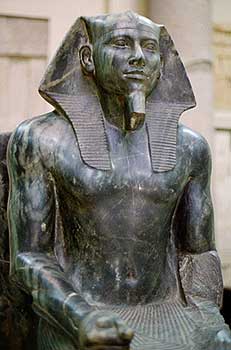
PEPI II NEFERKARE
Ascending the throne of Horus at the age of 6, Pepi II had the longest reign of any soverign in history: 94 years. He was happy when an ivory and ebony trader south of Nubia caught a pygmy, who Pepi requested be brought back to his court. The oldest 'travelogue' is the account of this traveler's adventures while on the hunt for these precious items. During the later years of this incredible amount of time, he ceded power to the vizier and nobles, who de-centralized the Old Kingdom. Indeed, Pepi II's death was followed by the end of pharaonic absolutism. His given name means 'Beautiful is the Ka of Re': Nefer = beautiful, ka, re.
2284-2184 Pharaoh of Egypt
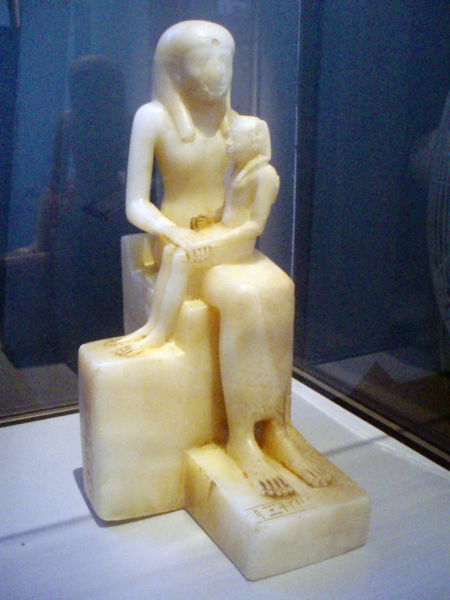
SESOSTRIS III
The centralizer and reorganizer of Middle Kingdom Egypt, Sesostris III undertook some expansive movements too. He had a canal dug through the first cataract of the Nile, built forts along the upper part of the river, and brought Nubia under Egyptian sway. He said, 'that son of mine who does not maintain my border, who does not fight for it, is no son of mine.' Unambiguious. He was worshipped as a god in Nubia, such was his reputation.
1878-1839
Pharaoh of Egypt
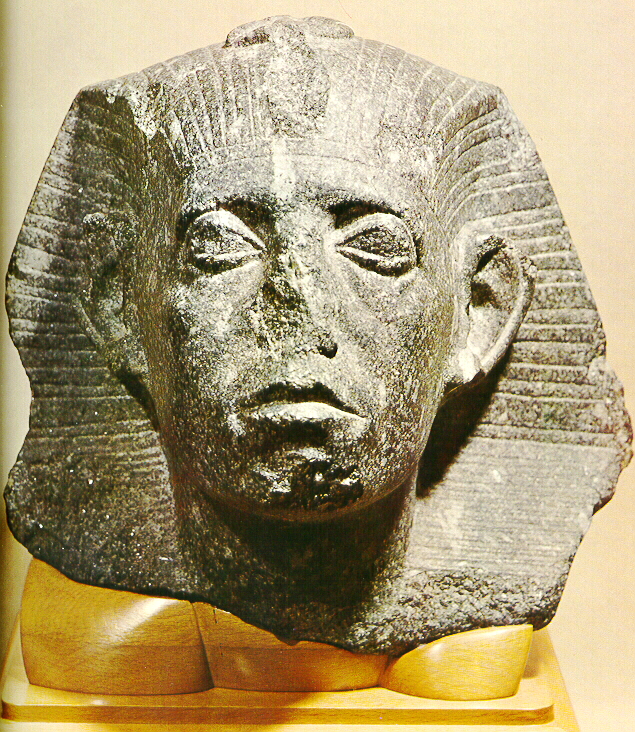
AHMOSE I
The Hyksos ruled Egypt for over a century, and finally a native rebellion led by Ahmose's grandfather, began the expulsion of the foreign occupiers. Ahmose assumed the duty to finish the job, and began rule from Thebes. He followed the Hykos out, beginning the New Kingdom Egyptian Empire, expanding to Nubia and across the Sinai in Canaan. He destroyed Hyksos settlements permanently. His huge building programs apexed in his own pyramid, the last of any pharaoh (remaining tombs would be under or on the ground). Monumental architecture was reinvigorated, the oldest glass in the world dates from his time.
1508-1458
Egyptian Pharaohess
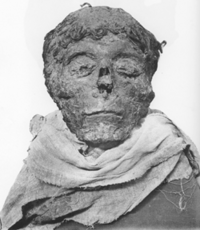
HATSHEPSUT
No, she was not Egypt's only female pharaoh, but she deserves her exhalted place due to her very successful rule. Not only did she reestablish broken trade routes to Asia disrupted by the Hyksos, but oversaw great building projects at Karnak and the great mortuary complex at the entrance to the Valley of the Kings. The tallest obelisk from Ancient times is hers. Traders visited the land of Punt where they brought back frankincense trees and myrrh. Her mummy was discovered in 2007 and DNA samples confirmed it: 18th Dynasty.
1508-1458
Egyptian Pharaohess
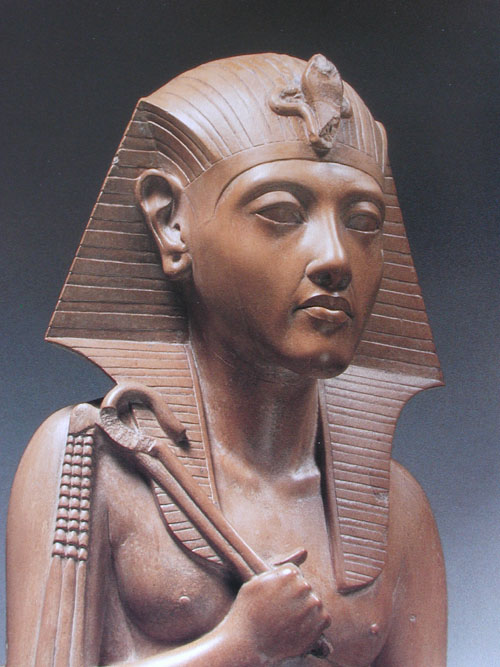
THUTMOSE III
Hatshepsut's son and head of her army, upon his mother's death he became the great conquerer of Egyptian history, "the Napoleon of Egypt," expanding the NKE to its greatest extent: Cannan, Syria, Nubia and the western desert, capturing 350 cities- even Meggido by a surprise move through a small mountain pass near Mt. Carmel, against the Canaanites. He bore down on them one at a time until they submitted. Back home, more was built at Karnak, gifts were received by Thutmose from the Assyrians, Babylonians and Hittites. Egypt pop. 3 million.
1490-1425
Pharaoh of Egypt
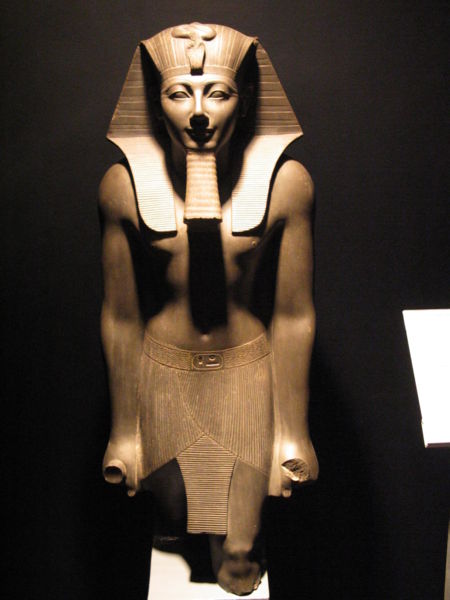
AMENHOTEP III
New Kingdom pharaohs valued splendor and pomp. Amenhotep III celebrated festivals with a procession of boats on the Nile, and dressed in special holiday garb. Members of the court were encouraged to get to know as many common people as possible, to build community. Transparency was valued, and feasts were attended by everyone, with beef, foul, bread and beer all served. Thebes was made into the greatest city of the time.
1430-1379
Pharaoh of Egypt
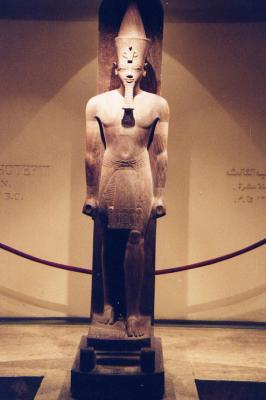
AMENHOTEP IV AKENATON
Ruler who converted Egypt to a brief monotheism possibly derived from contact with the Hebrews of the newly conquered empire.
1410-1360
Pharaoh of Egypt
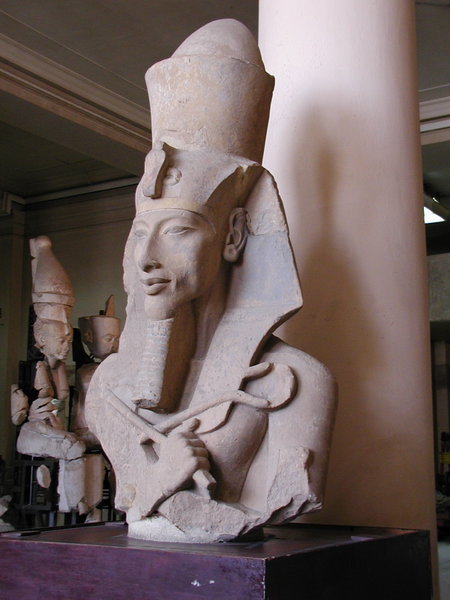
TUTANKHAMAN
Born Tutankhaton, Akhenaton the Sun worshipper was his father. But King Tut did the popular thing and changed religion back to polytheism, and reestablished Thebes as the capital and Memphis as the administrative capital. He changed his name to Tutankhaman (as in Amon-Re). A CT scan taken in 2005 showed that his leg had been broken, and he could have possibly died from an infection due to his broken leg. Discovered intact, the tomb of King Tut was the only one unmolested by grave robbers, so it was in death that Tut had his greatest effect, opening modern eyes to the splendor of Ancient Egypt. His jars, furniture, art, wine, pottery, jewelry, and tools- no to mention sarcophocus were all found.
1372-1352
Pharaoh of Egypt
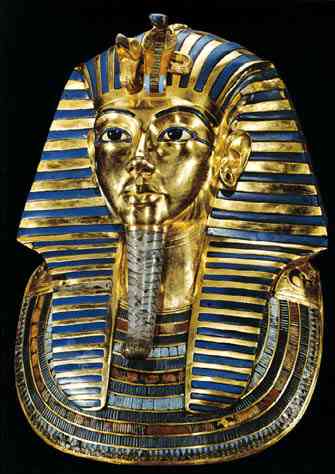
SETI
Ruler
1350-1295
Pharaoh of Egypt
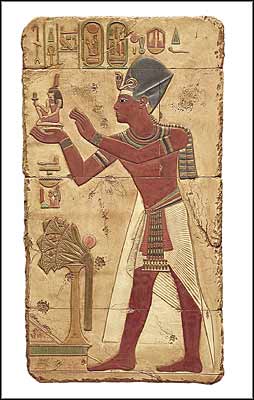
RAMSES II
What a personage, immortalized by Yul Brenner in The Ten Commandments, Ramses II was the 3rd Pharaoh of the XIX Dynasty. He had a very long reign of 66 years, he oversaw the clash of the great powers at Kadesh, built showcase cities, temples and monuments, led expeditions to Nubia, Palestine and Libya. He encountered Moses' deliverance and the chorus of the Hebrew slaves, and after those times, rebuilt Egypt as a prosperous and powerful imperial force. (KS)1315-1235
Pharaoh of Egypt
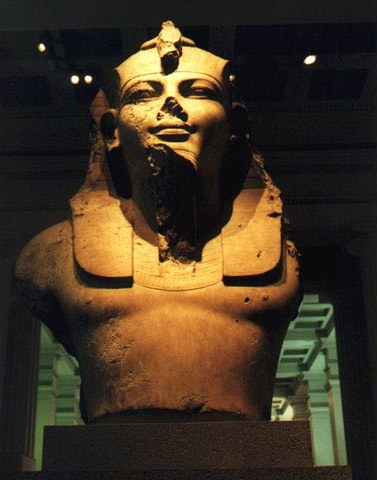
RAMSES III
20th Dynasty. His reign marked the end of the Bronze Age imperial powers, although Egypt was prosperous in and of itself. Ramses mined copper, had a tree-planting program and battled the Sea Peoples, invaded and destroyed the Hittites. In one last feat of Egyptian arms, he turned them away, and resettled them in Canaan, on the edge of the terminally weakened empire. These people would henceforth be called the Philistines.
1220-1156
Pharaoh of Egypt
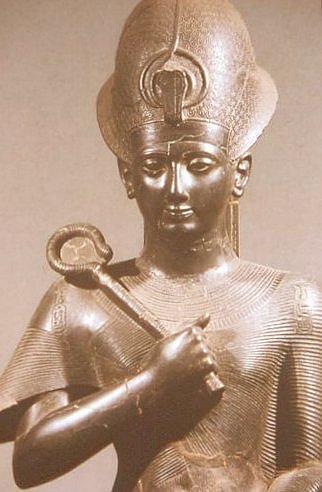
NECHO II
26th Dynasty. War with Babylonia was unsuccessful as Nebuchadnezzar was ruler. Necho built a canal from the Nile to the Red Sea, and sent out a Phoenician expedition all the way around Africa, which took three years. He was erased (almost) from monuments by later pharaohs for losing to Babylon. After him the New Kingdom was in a slow decline until its conquest by Persia and following that, by Alexander.
640-595
Pharaoh of Egypt
